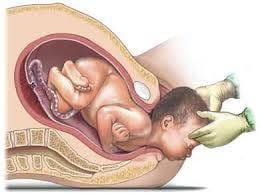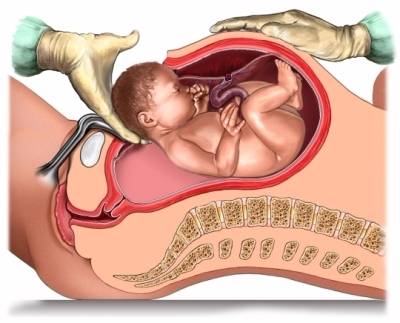Childbirth
From the moment a couple decides to have a baby, they gradually become more and more excited at the prospect of their impending parenthood.
After childbirth is over and the parents hold their precious baby in their arms, all the pain and anguish of the past is forgotten and the parents are overwhelmed with a sense of peace and happiness.
Vaginal delivery is the term used when the mother gives birth to her baby naturally and without, or with minimal, medical intervention. After a 40 week gestational period the baby is delivered through the birth canal (vagina). The placenta and membranes are also delivered this way.
Pregnancy in humans lasts for 280 days but only 5 percent of all babies are born on the expected delivery date. Most women give birth one week before the expected date of delivery.
Childbirth
Childbirth starts with the onset of regular uterine contractions, which the expectant mother can experience as pain. This is commonly called “labour”.
Normal completion of birth depends on three main factors. These can be classified as factors related to the uterus, the baby and the bone structure of mother. These three factors;
- Powers (contractions)
- Passageway (birth canal)
- Passenger (baby)
Contractions continue and when the cervix is fully dilated, help the mother to push the baby out. The baby needs to be in the correct position and unobstructed.
In order for a vaginal delivery to be successful, there should not be any incompatibility between the size of the baby’s head and the size of the mother’s pelvis. If the mother’s pelvis is too narrow or the baby’s head too large, then virginal delivery is not possible.
The first signs of the onset of labour are irregular contractions and a “show”. During pregnancy, the cervix is plugged with mucus. This protects the baby from external factors such as infection. Just before labour starts a slight opening of the cervix occurs and the mucus plug is expelled as a jelly like, bloody discharge.
Irregular uterine contractions occur throughout pregnancy. These are called “Braxton Hicks Contractions” also known as practise contractions or false labour pains. They become more noticeable as pregnancy progresses and once the mother gets closer to her due date, they become more frequent and intense.
The mother’s waters breaking are another sign of impending birth. Generally labour will start within 24 hours of the amniotic sac rupturing. Sometimes, however, labour will need to be induced.
False labour pains (Braxton Hicks) are irregular and intermittent and last for 15-20 seconds. True contractions are much more regular and grow stronger, longer and closer together. They will last for between 45 and 60 seconds and will cause effacement (stretching) and dilation (opening) of the cervix.
Real Labour Pains:
- Contractions will repeat regularly and intervals of contractions will frequently be 2-4 minutes apart.
- Intensity of contractions will gradually increase and last for 45-60 seconds.
- Causes cervical malacia and separation.
False Labour Pains:
- Contractions are irregular, their intervals are long and systematically do not repeat.
- Insensity of contraction will remain the same and cause temporary pain.
- Contractions will go away by resting and do not cause cervical seperation.
Sometimes the onset of labour is signified before any contractions start, by the breaking/tearing of the amniotic sac and the leaking of the amniotic fluid via the cervix and vagina (waters breaking).
* Amniotic fluid feeds and protects the baby against external trauma and infection. Once the amniotic membranes rupture (Waters break) both the baby and mother will be vulnerable to infection. Usually, contractions will start within 12 hours of the waters breaking. If this does not happen then it is necessary to artificially induce labour so as to minimise the infection risk to the mother and baby.
Especially, twinges start spontaneously within first 12 hours after waters break. If birth does not start unless this period expires, it will be suitable to induce the labour with artificial induction as the infection risk on baby and mother increases.
Labour has three main stages:
- First Stage of Labour: This is the phase from the beginning of contractions until full dilation of the cervix (10 cm).
- During this stage the baby’s head moves down the birth canal.
- Second Stage of Labour: This is the phase from full dilation of the cervix to the delivery of the baby.
- Third Stage of Labour: This is the phase from the delivery of the baby to the delivery of the placenta and membranes. Once this stage is over the birth is considered to be complete.
Sometimes, the mother will shiver after the delivery of the placenta. The reason for this is unknown and the shivering will stop spontaneously.
Birth Mechanism
* We still do not exactly understand what initiates childbirth. How does the mother’s body know that there is a baby growing inside it and when to activate the birth process? There are many theories on this subject, however, the process of birth remains a mystery.
* We do not completely understand what initiates childbirth, however we do know that contractions are triggered by the release of a hormone called “oxytocin” which is secreted by the pituitary gland in the brain. Another hormone called “prostaglandin” is also involved in triggering contractions. Understanding how these hormones work allows us to induce or stop contractions.
Cervical contractions are provided by hormone named as “oxytocin” secreted from pituitary gland of the brain. Also, some alteration in concentration of some substances called as “prostaglandin” can trigger these contractions. Knowing these mechanisms can give us a chance to induce or terminate cervical contractions.
When should you go to the hospital?
- The expectant mother should go to hospital once the contractions become more frequent and intense. Most women are able to tell the difference between Braxton Hicks contractions and true labour contractions.
- Sometimes amnion water can come without starting of labour pains. Breaking of water could be slow but consistent or it can suddenly soak the legs. In this case you should call your doctor immediately.
- Sometimes, the amniotic membranes can break or rupture before contractions start. This may just be a trickle or a gush of fluid. In any case, the mother should immediately contact her Doctor.
- Any bleeding during pregnancy should be taken seriously. It can indicate a problem and the mother should always consult her Doctor.
- Any decrease in the baby’s movements can be the sign of a problem. The mother should always consult her Doctor who will arrange for an Ultrasound and a Foetal Non-Stress Test (NST) to be done.


